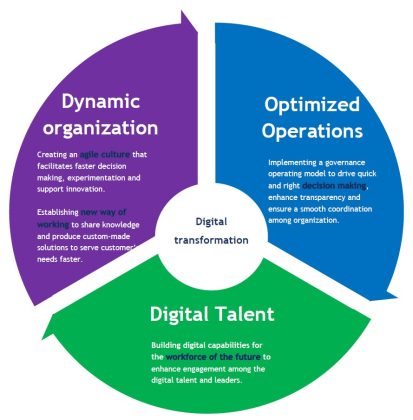Today, the digital opportunities are evolving faster than the pace of transformation in the organizations. To better understand the path our business is on, where to focus the efforts, and how to overcome the disruption and resistance to change, I decided to use this challenge as a topic for my Master´s thesis and created a roadmap for accelerating the digital transformation towards achieving my company’s future state (1). In the course of this research and development project, I realized several important things which I want to share with the readers.
What is Digital Transformation?
Many companies often end up with misunderstanding the concept of digital transformation. They often do not differentiate between beliefs and realities about digital transformation. Instead, before embarking on a digital transformation journey, companies need to become aware of a wide professional discussion going on in the professional world and be aware of key findings that business practitioners have came up with based on the experience of industry leaders. I summarize these key points below:
First, digital transformation is not just about implementing new technology. It is about the adoption of digital technology to improve business processes, value for customers and innovation. (2)
Second, digital transformation is not just a buzzword for business but a way to grow. Therefore, it requires clear targets for each source of value creation and ensuring that the entire company shares one digital vision.
Third, digital transformation is not optional, it is mandatory for business success. It helps company businesses gain a competitive advantage. (3)
Last, digital transformation is often mistaken for digitization or digitalization, but there are some significant differences. Digitization is, according to Wikipedia (4), the process of converting information into digital. Digitalization is, as Gartner (5) defines it, the use of digital technologies to change a business model and provide revenue and new value opportunities. While digital transformation is about transforming the customer experience and changing how to operate and deliver value to customers.
What does acceleration of digital transformation mean?
For most of digital services companies, the COVID-19 crisis has had an “all-or-nothing effect” on their digital strategy agenda. As reported by Deloitte (6), 77% of CEOs considered that the pandemic had sped up their company’s digital transformation plans. The crisis has significantly accelerated the digitization in terms of way of working and do business.
Many businesses have already embraced transformational change. However, this large scale change should be fast. To leverage the opportunities quicker and overcome the possible challenges faster than the competitors, you don’t have to rush to the corner shop to buy the smartest gadgets. Instead, your company will need to start enhancing systematically your organization culture, operations, and capabilities for the workforce of the future. This phenomenon is called acceleration of digital transformation.
McKinsey (7) suggests that the “digital first movers and fast followers capture more value within their industries than slower-moving companies”, taking the lead on digital transformation. It is just what Klaus Schwab, Executive Chairman of the World Economic Forum, said about the impact of speed on the business level: “In the new world, it is not anymore so much about the big fish which eats the small fish, it’s the fast fish which eats the slow fish.”
What are the key enablers of digital transformation?
The digital transformation is a journey where the desired destination and the path are different for every company. Like on any journey, a careful planning and a well-organized process would help the company to reach the destination safely and avoid back-roads and unnecessary costs. An analysis of the digital maturity of a digital services company, using BCG’s Digital Acceleration Index (8), reviled three relevant domains impacting its journey to successful digital transformation.
First, the operations optimization needs a systematic digital approach in decision making to improve the quality of work and ensure customer satisfaction.
Second, the digital talent is needed to enhance the changes to digital transformation to succeed points to building capabilities for the workforce of the future.
Third, the dynamic organization that lies in creating an agile culture and new ways of working.
As the figure below shows, the enablers for accelerating the digital transformation include precisely these three elements: the optimized operations, engaged digital talent & leaders, and dynamic organization.

The three key enablers of digital transformation (1).
In other words, the chances for a successful digital transformation will be greatly increased in case your organization is able of doing: quick decision making, building the digital capabilities for the workforce of the future, rolling out an agile culture, and establishing new ways of working.
What is a digital transformation roadmap and why do we need it?
Most importantly, making your organization succeed in the digital transformation needs a plan with clear steps and effective actions to achieve the goals as part of your growth strategy. Mapping out these steps on a timeline with clear milestones builds a digital transformation roadmap.
The roadmap that I proposed in my thesis for accelerating the digital transformation of my company that provides digital services defines three major elements to reach the digital transformation acceleration: 1) implementing a systematic approach in decision making, 2) building digital capabilities for the workforce of the future, and 3) creating an agile culture and a new way of working. By doing all of these, the company can better deliver relevant business outcomes to customers with fast payback and also enhance employee performance.
On an EndNote
Industry leaders often want to understand how far they are on the road of digital transformation. This was also the case with my organization that is concerned with the same question. After completing my investigation, my conclusion is this. Your organization is a digital transformation “performer” if (a) it has started to adopt the new ways of working, (b) has taken the efforts to build a more agile culture, (c) it has developed new digital capabilities, (d) it has a leadership mindset, and (e) it has streamlined the operations across its teams and organization.
About the author
 Violeta Tudose is a seasoned professional with a MSc in Computer Science and many years of industry experience. Currently, Violeta is a Huld Leader at Huld ltd. Recently, Violeta decided to take up yet another challenge and graduated as Master of Business Administration from the Master’s programme in Business Informatics. Welcome to contact Violeta via and her LinkedIn.
Violeta Tudose is a seasoned professional with a MSc in Computer Science and many years of industry experience. Currently, Violeta is a Huld Leader at Huld ltd. Recently, Violeta decided to take up yet another challenge and graduated as Master of Business Administration from the Master’s programme in Business Informatics. Welcome to contact Violeta via and her LinkedIn.
References:
(1) Tudose, V. (2022). Roadmap to Digital Transformation. Master´s Thesis. Metropolia University of Applied Sciences. Available from: https://www.theseus.fi/handle/10024/783038
(2) Shaban, H. (2022). Digital Transformation Process: 5 Factors That Can Empower Your Transformation Strategy: Blog. Apti.io (18 February 2022). Available from: https://www.apty.io/blog/digital-transformation-process
(3) Chakravarty, V., Wang, J, and Ahuja, S. (2021). Why digital transformation doesn’t have to be hard. (Online publication). Available from: https://www.ey.com/en_ph/board-matters/why-digital-transformation-doesnt-have-to-be-hard
(4) Digitalization. Wikipedia (Definition). Available from: https://en.wikipedia.org/wiki/Digitization (Assessed 24 November 2022).
(5) Digitalization. Gartner Glossary (definition). Available from: https://www.gartner.com/en/information-technology/glossary/digitalization
(6) Kane, G.C., Phillips, A. N., Copulsky, J., and Nanda, R. (2020). Digital Transformation through the lens of COVID-2019: A case of acute disruption. Deloitte Insights. Availabe from: https://www2.deloitte.com/us/en/insights/topics/digital-transformation/digital-transformation-COVID-19.html
(7) Booth, A., De Jong, E., Peters, P. (2018). Accelerating digital transformations: A playbook for utilities. McKinsey. Available from: https://www.mckinsey.com/~/media/mckinsey/business%20functions/mckinsey%20digital/our%20insights/accelerating%20digital%20transformations%20a%20playbook%20for%20utilities/accelerating-digital-transformation_a-playbook-for-utilities-vf.pdf?shouldIndex=false
(8) Boston Consulting Group, BCG (2020). Accelerating digital to build the ´bionic company´: BCG´s Digital Acceleation Index (DAI) to more digital maturity. Digital BCG. Available from: https://cdn.auckland.ac.nz/assets/auckland/business/our-research/docs/CODE/Accelerating%20digital%20to%20build%20the%20’bionic%20company’%20Framework%20and%20case%20study.pdf









Ei kommentteja